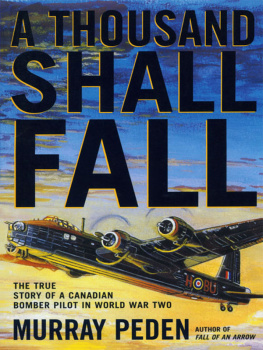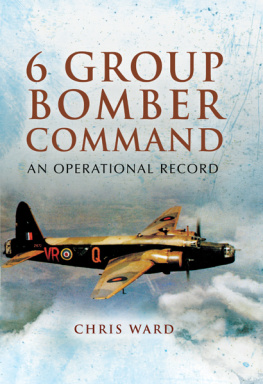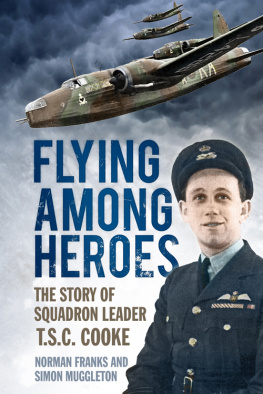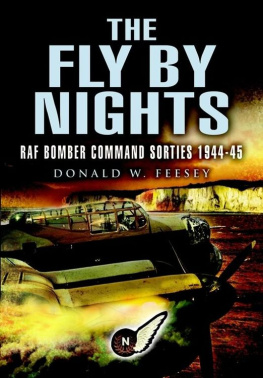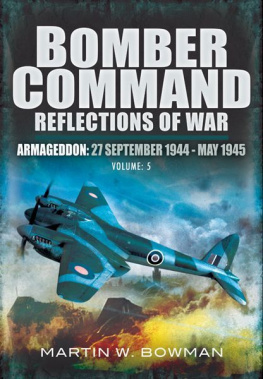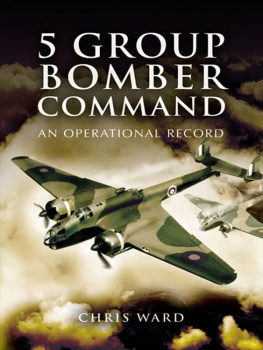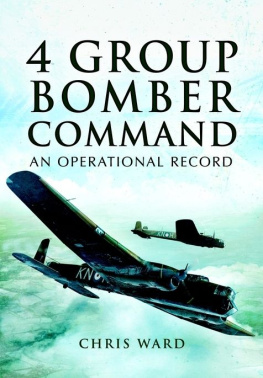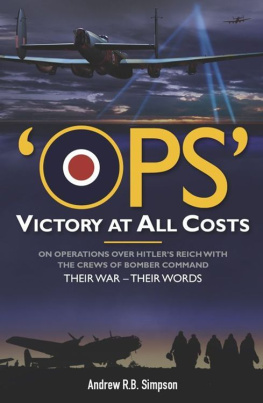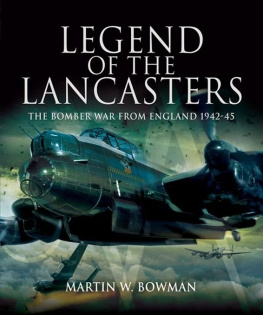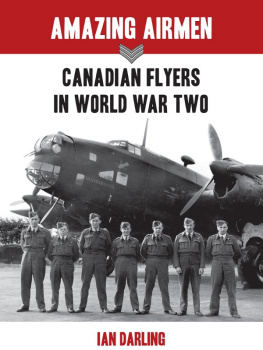
A THOUSAND
SHALL FALL
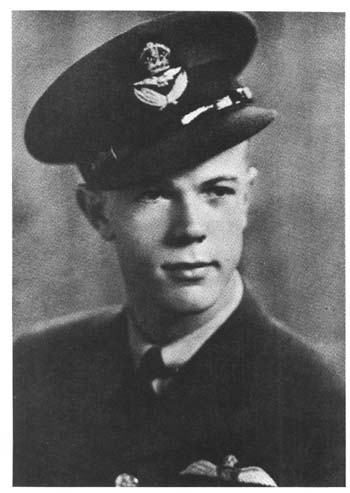
The author, newly commissioned (1942).
A THOUSAND
SHALL FALL
MURRAY PEDEN

Copyright 1988, 1979 by Murray Peden
All rights reserved. No part of this publication may
be reproduced or transmitted in any form or by any means,
electronic or mechanical, including photocopying, recording,
or any information storage and retrieval system,
without permission in writing from the publisher.
First published in 1979 by Canadas Wings Inc.
Reprinted in 1981
Published in 1988 by Stoddart Publishing Co. Limited
895 Don Mills Road, 4002 Park Centre
Toronto, ON M3C 1W3
Reprinted in 2000
Distributed in Canada by:
General Distribution Services Limited
325 Humber College Blvd., Toronto, Canada M9W 7C3
Tel. (416) 2131919 Fax (416) 2131917
Email cservice@genpub.com
Distributed in the United States by:
General Distribution Services Inc.
PMB 128, 4500 Witmer Industrial Estates
Niagara Falls, New York 143051386
Toll-free tel. 1-800-805-1083 Toll-free fax 1-800-481-6207
Email gdsinc@genpub.com
04 03 02 01 00 2 3 4 5
Canadian Cataloguing in Publication Data
Peden, Murray, 1923
A thousand shall fall
Updated ed.
ISBN 0-7737-5967-0
1. Peden, Murray, 1923. 2. Great Britain. Royal Air Force.
Squadron, 214 Biography. 3. World War, 19391945 Aerial
operations, British. 4. World War, 19391945 Personal
narratives, Canadian. 5. Bomber pilots Canada Biography.
I. Title.
D792.C2P43 1997 940.544941092 C97-932765-2
U.S. Cataloging-in-Publication Data available
from the Library of Congress
Cover design: Bill Douglas @ The Bang
Cover illustration: Stephen Quick

We acknowledge for their financial support of our
publishing program the Canada Council, the Ontario Arts
Council, and the Government of Canada through the
Book Publishing Industry Development Program (BPIDP).
Printed and bound in Canada
A thousand shall fall at thy side, and ten thousand
at thy right hand; but it shall not come nigh thee.
(Psalm 91)
This book I dedicate to
Tommy Penkuri, Rod Dunphy, Freddie Taylor, Francis Plate
and to
THE VANISHED ARMY
the army of young aircrew who died in combat in the skies over Europe. Over 55,000 aircrew were killed serving in RAF Bomber Command, thousands of that number being fellow Canadians. The crews faced formidable odds, odds seldom appreciated outside the Command. At times in the great offensives of 1943 and 1944 the short-term statistics foretold that less than twenty-five out of each one hundred bomber crews graduating from Operational Training Unit would survive their first tour of thirty operations. On a single night Bomber Command lost more aircrew than Fighter Command lost during the Battle of Britain. Yet the crews buckled on their chutes and set out with unshakeable resolution night after night. They fell prey to the hazards of icing, lightning, storm and structural failure, and they perished amidst the bursting shells of the flak batteries. But by far the greater number died in desperately unequal combat under the overwhelming firepower of the tenacious German night fighter defenders. Night after night the battle was joined. In the morning the swelling roar of hundreds of Cyclones and Twin Wasps heralded the start of complementary operations of the Combined Bomber Offensive flown by Fortress and Liberator crews of our redoubtable partners, the US Eighth Army Air Force. Those daylight operations were carried out only at the price of a matching tax in blood levied against the American aircrew. I remember them all, with pride, respect and enduring affection.
CONTENTS
by
Lt. Gen. Ira C. Eaker, USAF (Ret.)
One of the characteristic features of 1980 seems to be a revival of interest in the air battles of World War II. This was impressed on me since it has come to my attention recently that several books and motion pictures are in preparation for early release on phases of these aviation campaigns. New editions are also appearing of several recently released books on aviation subjects in response to this revived interest.
Among the best of these is Murray Pedens A Thousand Shall Fall. This is an unusually entertaining and factual account of the air war which Britain and her principal ally, the U.S., waged against the vaunted German Luftwaffe. Eventually won decisively by the former, it made the sea and land victories possible.
Peden was an 18-year old Canadian who enlisted in the Royal Canadian Air Force in 1941, was sent to England the following year, and served the next three years with courage and distinction as a bomber pilot.
Two U.S. Air Force officers who participated in some of the air campaigns of this period read the book, A Thousand Shall Fall, noted its unusual qualities and contacted the author: General Robert Dixon and Lt. General Ira C. Eaker. The former was a contemporary of Murray Peden in the RCAF, (a Spitfire pilot with the RAF) and prior to his retirement last year from the U.S. Air Force was commanding general for five years of Tactical Air Command.
I, as Peden knew, had commanded the U.S. Eighth Air Force from October 1942 to January 1944.
We have each agreed, at Pedens request, to write a foreword to the new edition of this book, each discussing it from his own experience, I from the co-operative aspect of command and control and Dixon from the viewpoint of the courageous combat crews.
From my arrival at the Headquarters of the RAF Bomber Command, October 20, 1942, with a directive from General Arnold to understudy the bomber operations of the British, prepare the plans and launch our bombing forces when I can get you some planes and crews, the RAF co-operated fully, in every possible way at all levels from Air Chief Marshal Portal, Chief of Staff, down the line and especially including Air Chief Marshal Harris and all his commanders and staff of Bomber Command.
Murray Peden mentions one of the retired Royal Air Force Seniors, Lord Trenchard, with deep affection and respect, as the father and founder of the RAF. All American leaders recognized Lord Trenchard, as did the RAF, as the author of the concept of strategic bombardment in World War I. He commanded the Independent Air Force in the late days of World War I, with a charter to conduct bombing operations beyond the battlefields of contending armies, against depots, rail networks and reserve forces, in order to affect decisively the land campaign.
It was Trenchard who influenced General William Mitchell and inspired his postwar campaign for a separate U.S. Air Force, which ultimately resulted in his court martial in 1925.
General Spaatz and I had contacted Lord Trenchard soon after arrival in England as observers in the Battle of Britain. He was alway skindly and courteous in a fatherly fashion. The visits of this world-famous partriarch to our combat groups, during the early operations, proved a valuable morale factor.
The day prior to one of these visits, I read in the London Times that Lord Trenchard had just lost his last son as a casualty in the Western Desert, the seventh son he and Lady Trenchard were to lose in World War II. I immediately called Trenchard saying I had seen that account, expressing my condolence and saying I would not call for him as planned, as we certainly did not expect him to leave Lady Trenchard in such a tragic time. He promptly stated that the visit to our groups should not be cancelled. His loss only confirmed his determination to carry on, doing whatever he could to destroy the Nazimenace. He did say that he would appreciate it if I could arrange that no mention of his late loss be made to him on the upcoming visit to our bases.
Next page
